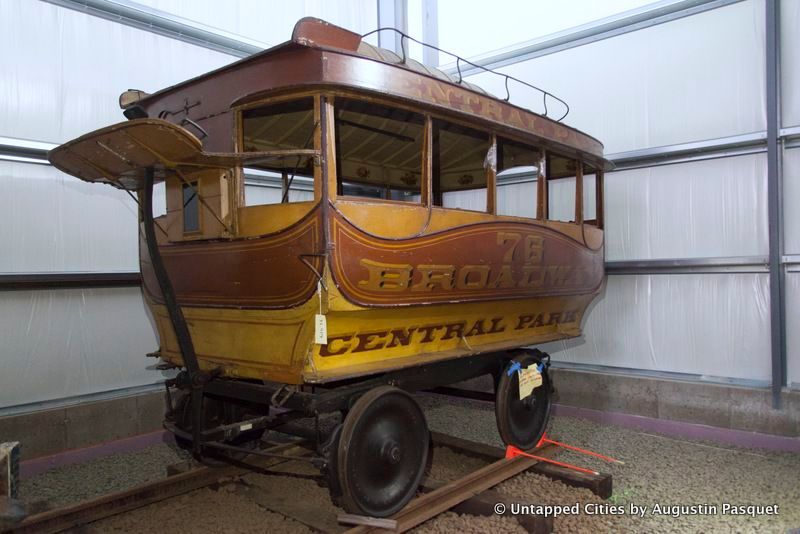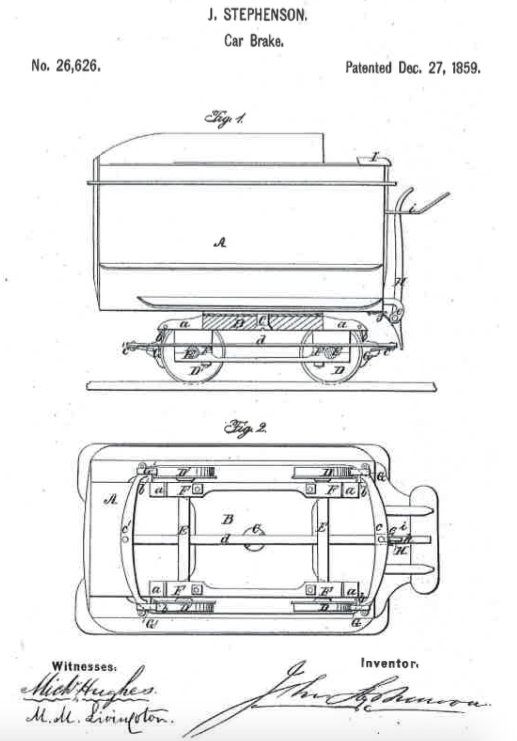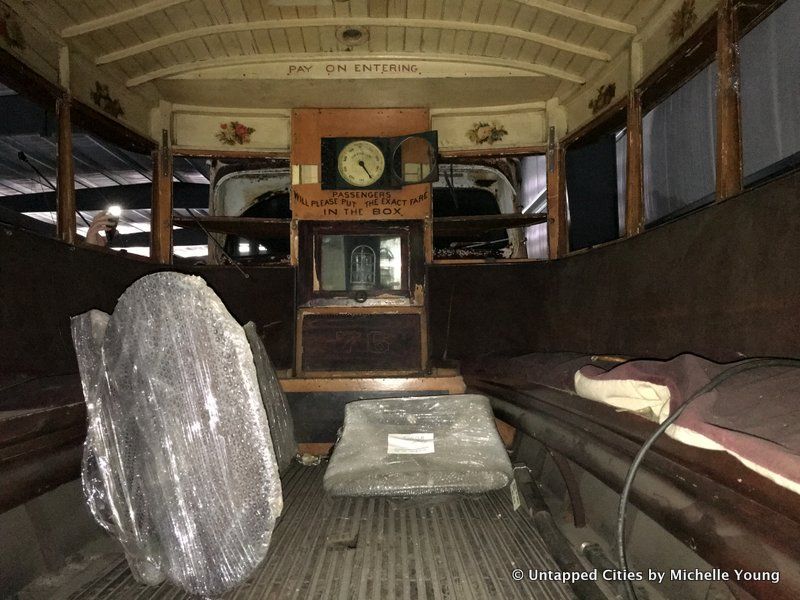A Salvaged Banksy Mural is Now on View in NYC
This unique Banksy mural goes up for auction on May 21st in NYC!


Earlier this month, we tracked down the incredible private subway car of August Belmont Jr., the financier for the first subway line in New York City at the Shore Line Trolley Museum in Connecticut. Another find in this amazing museum, which has over 100 vintage trolley and subway cars, is the horse drawn trolley car, the Horsecar 76. It’s believed to be the oldest preserved streetcar in the world. This adorable trolley was tucked in the back of one of the museum’s brand new storage barns, built 17 feet above the 500 year flood plain.
The type of streetcar, known as a reversible horse car, could actually rotate 360 degrees on its undercarriage utilizing a single pin, so when the trolley needed to go in the reverse direction along the rails, the horse and the cab would just rotate around. It was built by John Stephenson & Co., an important streetcar and rail manufacturer, who patented the braking system for the reversible horsecar in 1859. Starting in 1843, Stephenson was producing streetcars from a six-story factory he built on Madison Avenue and 27th Street, across from the depot of the New York & Harlem Railroad.

Horsecar 76 already shows concepts Stephenson would develop further about the design of horsecars and street cars, including roof windows and clerestories for light and ventilation. Stephenson called the clerestory level a Bombay roof, inspired by the types of vehicles from the Indian city. The Stephenson horse trolley was also lighter than other comparative types, and required only one driver and one horse.

US Patent # 2626 by John Stephenson from 1859. Image via the Branford Electric Railway Journal
It’s unclear when Horsecar 76 was actually built but an article in the Branford Electric Railway Journal goes in depth attempting to narrow a time frame, somewhere between 1853 and 1862.
It’s also unclear which streetcar company operated Horsecar 76. It is known that the Sixth Avenue Railroad purchased nine horsecars in 1856, and another nine a year later. The painted CENTRAL PARK signage below the windows does not indicate that the trolley ran within the park, but rather was perhaps the destination of the trolley. The 6th Avenue Railroad did have a stop at 59th Street by 1856. Later archival photographs show that the Central Park sign above the windows once read, “8 AV, CANAL STRET.”
The conundrum of the horsecar’s signage and usage are even more befuddling than described here, but in the end, this trolley somehow ended up in the possession of the Second Avenue Railroad Company, though a Central Park stop was not part of that company’s jurisdiction. As the Branford Electric Railway Journal article writes, “The Second Avenue Railroad wound up with this car, which Stephenson claimed was used on Sixth Avenue, and is lettered for Eighth Avenue!”

Interior of Horsecar 76 today
Despite the horsecar’s technological innovations, its passenger capacity was simply too low to be effective in dense urban centers. For at least 35 years, the Horsecar 76 was used as a ceremonial car for special events, such as the below image from 1897. It was a test run for the conversion to electrical conduit operation on the Fourth Avenue line, but as The Street Railway Review reported at the time, “Several members of the Board of Aldermen were guests, but before the trip was finished they had all the enthusiasm shaken out of them.”
Horsecar 76 makes another appearance in newspaper photographs in 1923, used in a parade down Fifth Avenue to celebrate the 26th anniversary of the unification of the five boroughs.
In 1933, the Second Avenue Railroad transferred Horsecar 76 to the Museum of the City of New York where it was on view until the early 1980s. It was moved into storage at Bush Terminal during museum renovations, but when the Brooklyn Nets rented space there to use for indoor practice courts, the lease with the museum was terminated.
The Museum of the City of New York reached out to the New York Transit Museum but Horsecar 76 could not fit in the decommissioned IND subway station the museum calls home. As Chelsea Newburgh, from the New York Transit Museum tells us,”Our Curatorial team reached out to the Shore Line Trolley Museum’s President Emeritus and longtime Transit Museum volunteer, Bill Wall, and it was agreed upon by everyone at MCNY, NYTM, and SLTM that SLTM was the best home for the historic car.” The move was quite an adventure, as recounted in the Branford Electric Railway Journal article, but it finally arrived at the Connecticut museum on December 5th, 2014.
We are coordinating a tour to the Shore Line Trolley Museum to see this car, the August Belmont Jr. private subway car, and more from the extensive collection of vintage trolleys and trains. Sign up for advance notice here:
#mc_embed_signup{background:#fff; clear:left; font:14px Helvetica,Arial,sans-serif; }
/* Add your own Mailchimp form style overrides in your site stylesheet or in this style block.
We recommend moving this block and the preceding CSS link to the HEAD of your HTML file. */
(function($) {window.fnames = new Array(); window.ftypes = new Array();fnames[0]=’EMAIL’;ftypes[0]=’email’;}(jQuery));var $mcj = jQuery.noConflict(true);
Next, see photos of the Belmont private subway car and read about the secrets of the NYC subway.
Subscribe to our newsletter